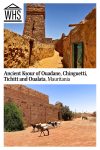Ancient Ksour of Ouadane, Chinguetti, Tichitt and Oualata
By Abigail Dalton
What are the Ancient Ksour of Chinguetti, Ouadane, Tichitt and Oualata?
The Ancient Ksour of Chinguetti, Ouadane, Tichitt and Oualata are historic desert towns in the heart of Mauritania – a country often overlooked on the edge of the Sahara.
These four towns were founded in the 12th and 13th centuries and became key trading posts along the Trans‑Saharan caravan routes. Over time, they grew into important religious centres, known for their Islamic learning and culture.
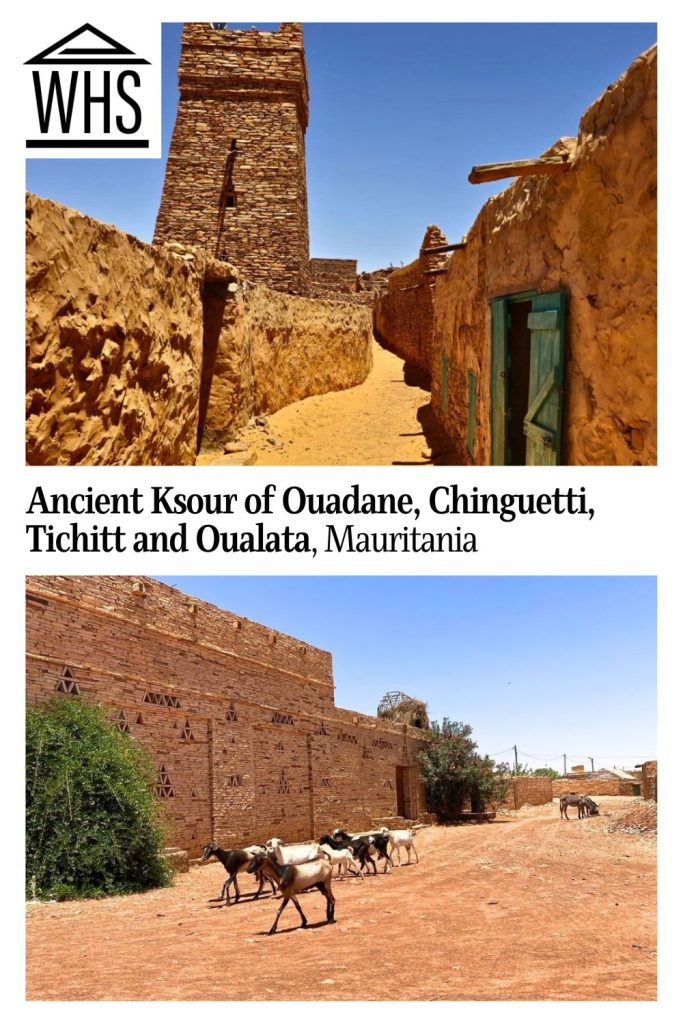
Disclosure: This article contains affiliate links. Making a purchase through an affiliate link will mean a small commission for this website. This will not affect your price. Privacy policy.
Life here thrived between the 12th and 16th centuries despite the harsh desert conditions. Their survival and growth are a fascinating example of how people adapted to extreme environments.
Each ksar (meaning fortified town) follows a similar layout. A central mosque anchors the town, with tightly-packed stone houses, shaded courtyards and narrow winding lanes. In some places, you can still see original stonework and decorative details – beautiful touches that hint at the deep cultural and spiritual life these towns once held.
Today, the ksour remain a UNESCO World Heritage site and a reminder of Mauritania’s ancient history and resilience.
Why are the Ancient Ksour of Chinguetti, Ouadane, Tichitt and Oualata a UNESCO World Heritage site?
These towns aren’t just old trading posts. They’re some of the best surviving examples of how people once lived and built in the Sahara. The placement of these medieval ksour and their growth as centres of Islamic learning hold huge historical value.
This legacy has allowed the ksour to remain important cultural landmarks for generations. Furthermore, their unique architecture and culture reflect this history and are exactly why UNESCO recognises them as places worth protecting.
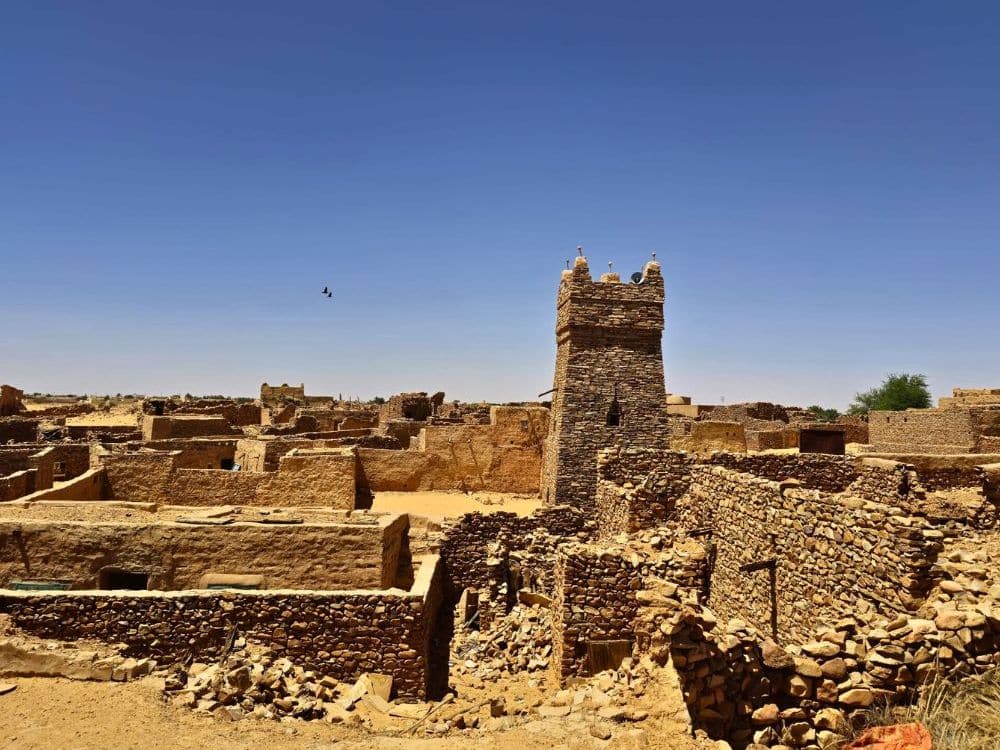
According to UNESCO, “These living historic towns are an outstanding example of traditional human settlements and the last surviving evidence of an original and traditional mode of occupying space, very representative of the nomadic culture and long-distance trade in a desert environment.”
It’s this mix of history, culture and resilience that makes them so special. The ksour are not just ruins – they’re living towns that still reflect the same spirit, design and way of life that shaped them centuries ago.
As a UNESCO World Heritage Site, they are protected as rare examples of desert urban life and treasured for the role they played in connecting people, ideas and trade across the Sahara.
What can you expect on a visit to the Ancient Ksour?
Chinguetti
Like much of Mauritania, Chinguetti feels like stepping into a forgotten world. The old town, home to the ancient ksar, is both fascinating and a little eerie. Walking through the maze‑like lanes feels like wandering through a ghost town, with crumbling walls and drifting sand slowly swallowing parts of the settlement.
Yet, it isn’t empty. Life hums quietly behind wooden doors that don’t quite fit their frames. There are small shops and rooftop tea rooms to be found – expect cushions laid on the floor, where the tradition of atay (the Mauritanian tea ceremony) is shared with pride.
Chinguetti’s highlight is its libraries. The city once held dozens of them, filled with ancient Islamic manuscripts and scientific texts. Today, only a handful remain, each home to priceless volumes.
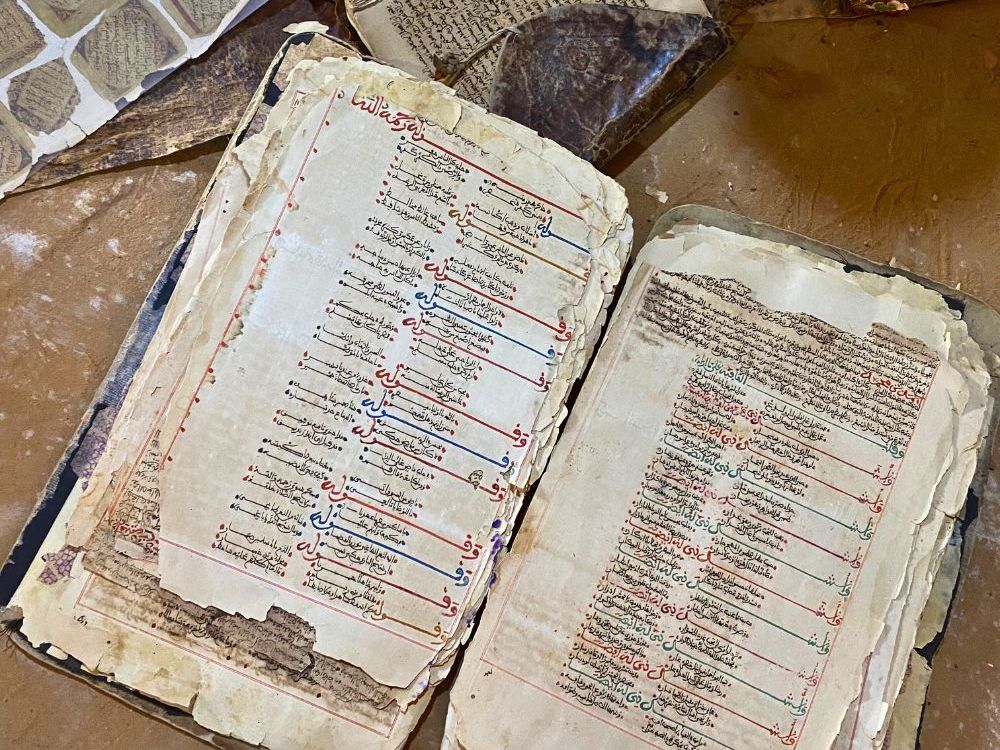
The community is curious and friendly. Tourism has grown a little in recent years, but it’s still far from a mainstream place to visit. Chinguetti is an offbeat destination, and the infrastructure reflects this.
Unfortunately, the city is experiencing struggles with changing weather and economic hardship. Nevertheless, Chinguetti remains an undeniably fascinating place to visit.
The weather is typically very hot and dry, with cooler evenings, especially in winter months. Pack light layers and be ready for sand and sun.
Accommodations are simple but welcoming. Most guesthouses are basic, with clean rooms and shared spaces. Hosts are usually happy to offer advice or arrange a guide – often a relative – who can show you more of the ksour and surrounding desert.
Find accommodations in Chinguetti.
Ouadane
(Not yet available. If you’re a blogger and can contribute 200-250 words and a photo, please contact rachel(at)rachelsruminations(dot)com.)
Tichitt
(Not yet available. If you’re a blogger and can contribute 200-250 words and a photo, please contact rachel(at)rachelsruminations(dot)com.)
Oualata
(Not yet available. If you’re a blogger and can contribute 200-250 words and a photo, please contact rachel(at)rachelsruminations(dot)com.)
Are the Ancient Ksour of Chinguetti, Ouadane, Tichitt and Oualata worth visiting?
The UNESCO World Heritage Sites of Chinguetti, Ouadane, Tichitt and Oualata are absolutely worth visiting for their unique architecture and rich cultural heritage.
Although each old town is small and easy to explore in a day, the remoteness and character of these ksour make them fantastic places to spend a night or two.
While there, take time to explore the surrounding area. You’ll find desert oases, sweeping dunes – perfect for camping under the stars – and opportunities for camel rides.
Choosing to visit the ksour, even just overnight, is one of the best ways to experience local life as it still exists in these desert towns. Share tea with locals, wander the lanes, and learn more about their history and why these sites are so important to the community.
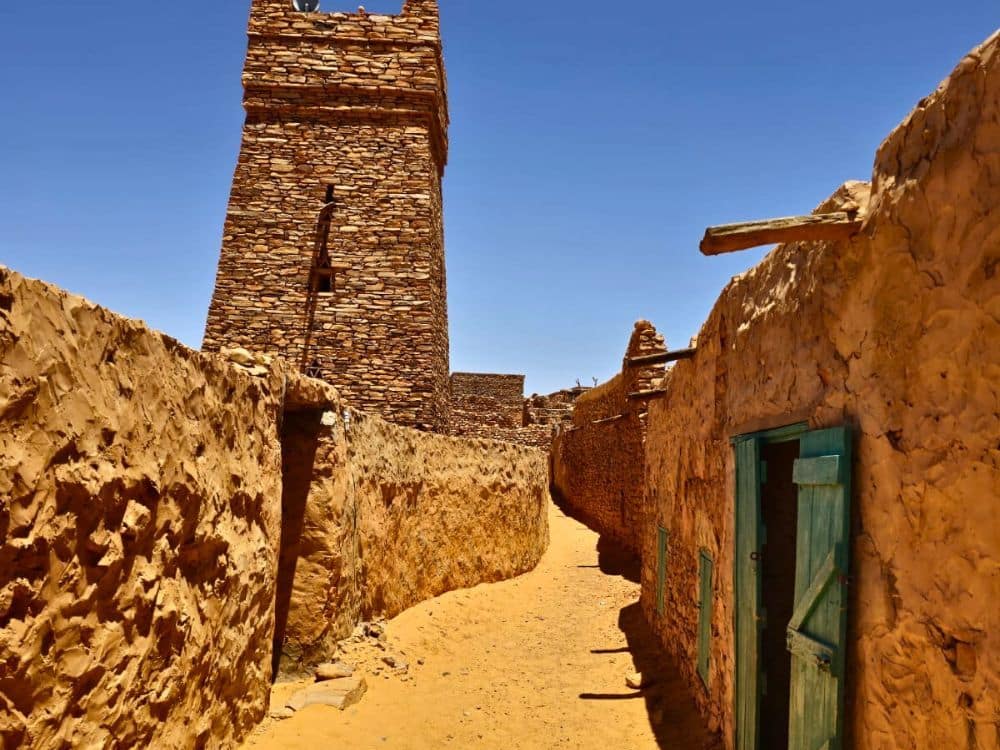
What sorts of travellers would like these ancient ksour?
For those who enjoy stepping off the beaten track, the ancient ksour are a dream. They are ideal for anyone curious about Islamic culture, fascinated by old architecture, or drawn to places with a strong story to tell.
In a way, visiting these towns is like walking through an open‑air museum, but with life still carrying on around you and centuries‑old buildings slowly weathering in the desert winds.
They’re perfect for travellers who appreciate history, desert landscapes, and places that feel untouched by time. If you enjoy slower travel and don’t mind simple comforts, you’ll find these ksour deeply rewarding.
This 10-day tour of Mauritania includes Chinguetti and Oadane, with an overnight stay in each, among many other sights. This more adventurous tour is only four days, but includes a stop in Chinguetti and a 12-hour ride on the famous iron-ore freight train. And this 8-day tour includes both Chinguetti and Oadane as well as the iron-ore train.
Tips for visiting the Ancient Ksour in Mauritania
Mauritania is truly an offbeat country with minimal tourist infrastructure. Therefore, getting around the country can be challenging and time-consuming. This is especially true if using public transport.
One of the most important things to remember when visiting Mauritania is patience.
Within the Ksour, walking is the best (and sometimes only) way to explore; however, reaching the towns can be a laborious journey. Expect delays and allow yourself plenty of time to arrive at your destination.
The nearest airport is in Atar; however, there never seem to be flights available for online bookings. Most international flights arrive in Nouackchott, the capital; from here, travel to the ksour is via road.
Shared taxis, which generally consist of mini-buses, are a popular means of transport. Alternatively, hiring a private driver is common among tourists but unless in a group it can get expensive.
Tap water isn’t safe to drink. Take a filter bottle and fill up before heading out each day.
Mauritania is a Muslim country and a dry state – alcohol is prohibited. To avoid unwanted attention, it’s best to dress modestly, covering both shoulders and legs. Wearing a headscarf in public areas is appreciated.
Most visitors will need to apply for an e-visa online before entering Mauritania. The e-visa costs €55 or $60 and must be paid on arrival in Mauritania in exact cash in Euros or US dollars – change is not given.
Mauritania uses the Mauritanian Ouguiya (MRU). Cash is essential, but consider using mobile money apps like Wave or Orange Money for everyday payments if obtaining cash is a problem.
Nouakchott has ATMs that accept foreign bank cards, but they are scarce, and there are few ATMs or bank facilities in the rest of the country. Withdrawal limits can be low, and ATMs regularly run out of money.
If you are going to be in Nouakchott, consider visiting Mauritania‘s other UNESCO site as well: Banc d’Arguin National Park, which is north of the capital on the coast.
As for exploring the ksour, it’s well worth hiring a local guide. This is especially rewarding when visiting the libraries in Chinguetti, as a guide can translate and help you gain a much deeper understanding of what you’re seeing.
If your onward travel will take you to Senegal next, make sure to visit the Island of Saint-Louis. It’s not far from the border and also a UNESCO site.
Where are the Ancient Ksour?
The ancient ksour of Chinguetti, Ouadane, Tichitt and Oualata are scattered across the heart of Mauritania, deep in the Sahara. They lie in remote desert regions far from the coast and modern cities, which adds to their untouched feel.
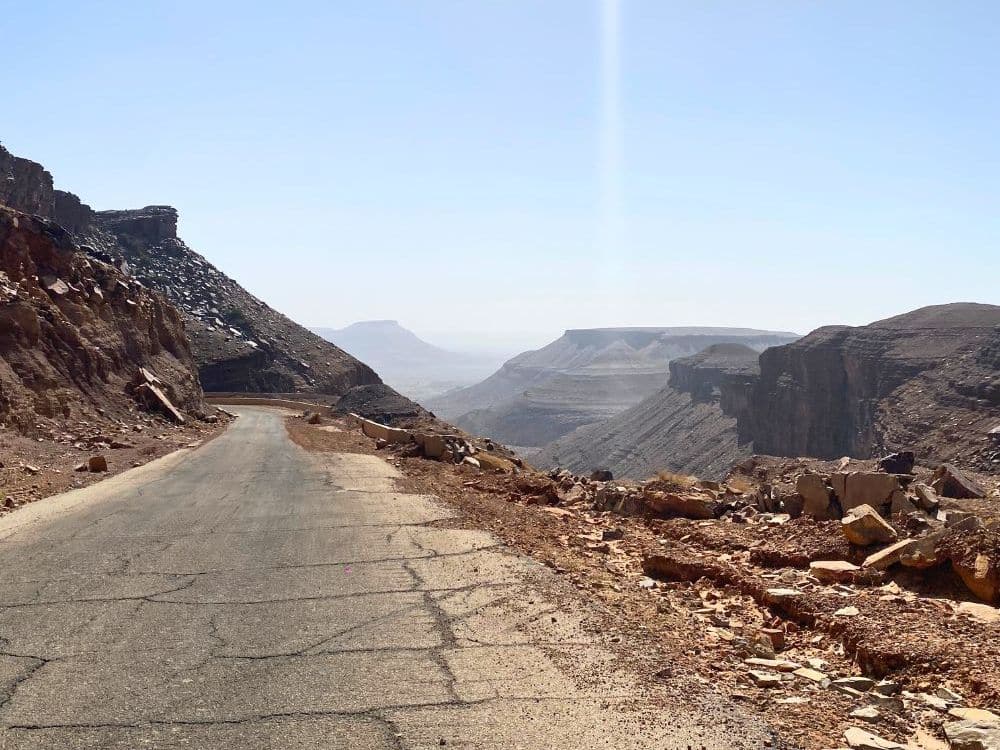
The most visited ksar, Chinguetti, is in central‑western Mauritania, about 90 km (55 miles) northeast of the town of Atar. From Atar, the drive takes around 2 hours on rough desert roads.
Ouadane is further northeast, roughly 120 km (75 miles) from Chinguetti. The road is unpaved and bumpy, but the shifting desert scenery makes the journey part of the adventure.
Tichitt lies in the Tagant region, far more isolated. It’s southeast of Tidjikja and best reached with a 4×4 and an experienced driver.
Oualata is in the far southeast near the border with Mali. Reaching it often involves long desert drives and planning fuel and supplies in advance.
Atar or Tidjikja provide a good base and where local guides or private 4x4s to visit can be arranged. Public transport is limited and unpredictable. Shared taxis and bush trucks do run, but they can take much longer and aren’t always reliable.
Visiting the ksour means planning ahead, but the reward is arriving somewhere few others have been – small desert towns where history and daily life blend together.
For more information about the Ancient Ksour of Chinguetti, Ouadane, Tichitt and Oualata, see Mauritania’s tourism website (in French – use a translation app).
Have you been to any of the Ancient Ksour? If so, do you have any additional information or advice about this UNESCO World Heritage site? Please add your comments below!

